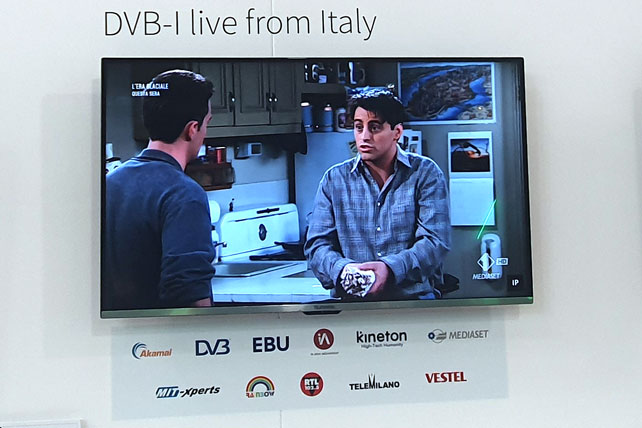
Preparing the way for a full DVB-I market trial in Italy
Visitors to the DVB booth at IBC2023 were able to navigate through the DVB-I service list for a market trial that’s taking shape in Italy. There is more information on the demonstration and the elements of the trial in the handout that was distributed during IBC. Earlier in the month, Marco Pellegrinato, Standards & Innovation Director at Mediaset, provided an article on the background to the trial for Issue 62 of DVB Scene magazine – the article is republished here in full.
In 2022, with the ‘re-farming’ of the 700 MHz band in Italy, many broadcasters lost the capability to broadcast on DTT (digital terrestrial television) networks, due to the lack of spectrum to carry all of the required DVB-T multiplexes. Broadcasters in this situation were allowed to use the LCN (logical channel number) assigned for their DTT service to start linear IP streams, which are made available via an HbbTV app.
This is an interesting opportunity when it comes to the possibilities for a market trial of DVB-I in Italy, building on the technical trial and proof-of-concept that Mediaset and partners have been running since 2019. Since many broadcasters are already reusing their DTT LCN to stream linear channels, via HbbTV, they can use the same approach in the context of a DVB-I trial. It means such an initiative can be open to all broadcasters already licensed to broadcast in Italy using their own LCNs.
It is possible that the regulatory authorities in Italy will soon open a ‘technical table’ on the matter of DVB-I and HbbTV technology, to define a complete assessment and allotment of possible rules and LCN numbers to deploy DVB-I services in the future. This could lead to the announcement of a new set of rules – in Italian a delibera – about the prominence of services, including perhaps some references to DVB-I services.
Regulatory questions
It is a question for the regulator to define what would represent a licensed broadcaster and a licensed streamer (or ‘broadbander’), and specifically to decide whether IP-only services would be allowed. Furthermore, there are many reasons why an existing broadcaster might not want to join a DVB-I platform at this stage. These are not technical questions – they are regulatory matters.
For Mediaset, DVB-I offers an opportunity, in the context of the re-farming of the 700 MHz band, and potentially the 600 MHz band in future, to find another way of reaching our audiences in case we are required to reduce our number of DTT multiplexes. This is why we originally started the proof-of-concept and why we are now keen to move towards a real market trial.
Most of the regional or local broadcasters in Italy already serve their own streams via HbbTV. DVB-I, however, could offer a more integrated solution than streaming through individual HbbTV apps. That’s because DVB-I provides a user experience that is already familiar to all television viewers. We are cooperating with most of the regional and local broadcasters, specifically under the auspices of their association, Confindustria RadioTelevisioni, to smooth the way towards the adoption of this new technology.
